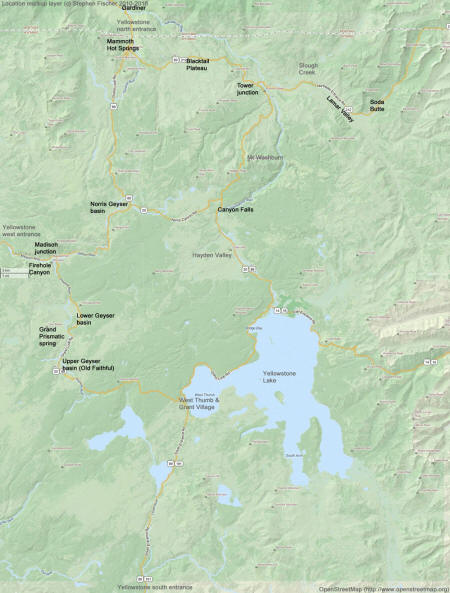Grand Tetons and Yellowstone (page 3 of 3)
September 18-25, 2010

After exploring the northern part of Yellowstone park, we headed back south and decided to base camp back at Madison for the next 2 nights.
This time we got much luckier in terms of elk related photography.
That evening along Madison River and confluence with the Gibbon River we
encountered a male elk and its harem of about 8 female elk.
This
provided many opportunities under warm lighting opportunities around
sunset along the river bank. The next morning was equally productive
within walking distance from the campsite. It was quite a spectacle to
see the goings-ons of the male elk, as he obviously was in want of
companionship, while the females only seemed interested in his protection,
but nothing more. Every time the male would advance on a cow, the cow would
turn and walk away, causing the male to sometimes wail out a cry in
frustration. We also witnessed the male peeing on the surrounding ground, and
what also looked like himself. Talking to some locals, apparently they do
this just like dogs, coyotes, or wolves to mark their territory, letting other male interlopers
know that this area is theirs. In some cases the female elk would get uncomfortably close to
us photographers, causing the protective male elk to come trotting over to
check out the situation. Sometimes this would require backing away to avoid
getting in the wrong place and potentially provoking a charge by the male.
Given their size and their antlers, no one felt like testing if their
supposed false charges they are known to make were exactly that.
While
based in the central area of Yellowstone we also explored via some day hikes
including Fairy Falls behind the lower geyser basin plus a hike to the top
of Mount Washburn on the next day. On the trip to the falls, there is
also an opportunity to photograph the Chromatic geyser basin from a small
hill. There is an ad-hoc trail that you can scramble up about 100
yards to give you a scenic vantage point. Continuing on to the falls, in comparison to some of the other
falls in Yellowstone, Fairy Falls requires some additional creativity in
order to generate something more interesting as a piece of photographic art.
Steve tried scaling the slopes on either side in search of a better
foreground, but settled on just using the rocks in the stream in front with
camera at a very low angle. On some of these hiking trails you can experience more of the nature, while
also potentially getting yourself in more trouble as there are no rails or
fences to prevent you from getting too close (as demonstrated to the left
when Randy was checking out this particular geyser). On the return from this
particular hike we also happened across another large bison that decided to
lounge on the trail in front of us. After a few moments it wandered
off, allowing us to proceed.
The
3 mile hike up Mount Washburn the next morning was a good opportunity to stretch the legs and to
get a great vantage point for most of the park. Photography-wise, the hike
up the mountain is not as interesting unless you can get lucky in spotting
some wildlife (Cliff and Don managed to photograph a red fox passing through
the area, while Steve was able to capture a Coopers hawk). At the top there
is a nicely enclosed fire look-out complete with bathrooms (there is a full
time look-out employee who lives up there). To bad it was not like the Swiss Alps
where you could be rewarded for your climb with coffee, hot chocolate, or
beer with a nice lunch. Perhaps one day some entrepreneur will sieze upon
this idea and bring it to the states.
To wrap up this story, visiting the Grand Tetons and Yellowstone was a successful trip photography-wise. Camping allows you to be in a better position for the right lighting at early morning or evening. The latter half of September or early October is advantegous for a few reasons: The number of tourists is less, the fall colors will be out, and the rutting season for the elk will have begun. I couldn't imagine visiting Yellowstone in the summer, as it probably would have numerous traffic jams with a multitude of people visiting the various geysers or whenever some animal would cross the road. If you wait until late October, then you run the risk of colder weather or snow that may limit travel or ability to more easily camp. The next visit for Steve to this area may be in the winter in an effort to specifically photograph the wild wolves, but more planning will be required before bottoming on such a trip...
- Stephen Fischer
|
Elk Magnificence |
Morning graze |
Nooo! |
Chromatic basin |
|
Yellowstone autumn |
Call of the wild |
Fairy falls |
Rivers of steam |
Page 1 - Grand Tetons Page 2 - Yellowstone (part 1) Page 3 - Yellowstone (part 2)